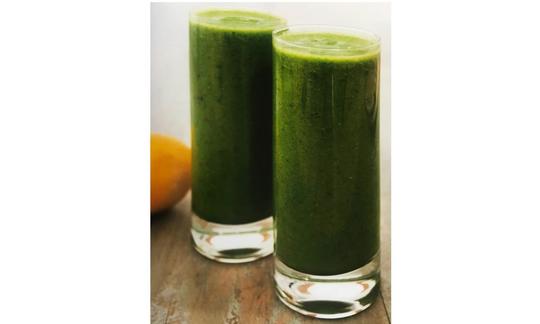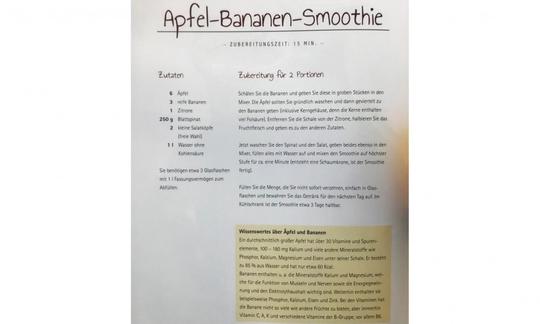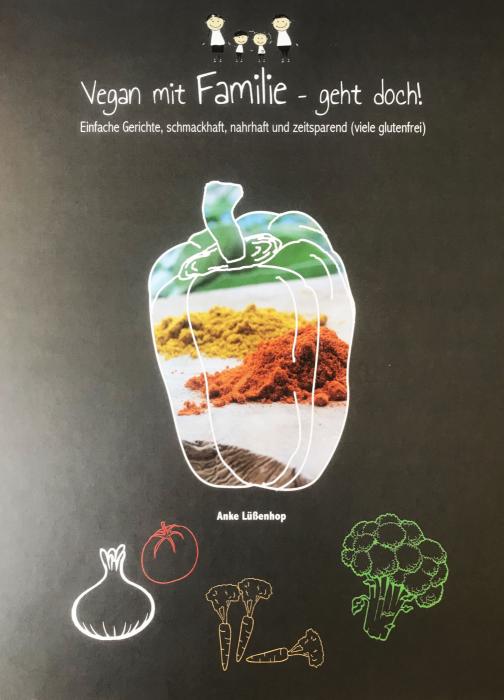Apple-banana smoothie with spinach and salad
raw-vegan
Ingredients (for servings, )
| 3 | Bananas, raw (organic?) (12 oz) |
| 6 | Apples, raw, with peel (32 oz) |
| 1 | Lemons, raw (limes, organic?) (2.0 oz) |
| 8 ½ oz | Spinach, raw (vegetable spinach) |
| 2 small | Lettuce, (Butterhead group), raw, organic? (21 oz) |
| 1 liter | Drinking water, raw (organic?) (35 oz) |
Equipment
- blender
- salad spinner
Type of preparation
- food preparation without heating
- blend
- peel
Preparation
Preparation of the apple-banana smoothie
Peel the bananas and put them in the blender in large pieces. Wash the apples thoroughly and then quarter them and add them to the bananas.Also use the core of the apples, as the seeds contain a lot of folic acid.
Remove the peel from the lemon, halve the flesh and add it to the other ingredients.
Now wash the spinach and lettuce, put both in the blender, fill everything with water and mix the smoothie at the highest setting for about a minute (if a head of foam forms, the smoothie is ready).
The author drinks only still water, not mineral water.
Filling - enjoying and if necessary preserving
Simply pour the amount you don't consume immediately into glass bottles and store the drink for the next day.You will need about 3 glass bottles with a capacity of 1 litre to fill the amount we have designed for 4 people.
Shelf life: The smoothie will last for about 3 days in the refrigerator.
|
Nutritional Information per person
Convert per 100g
|
2000 kcal | |
|---|---|---|
| Energy | 234 kcal | 11.7% |
| Fat/Lipids | 1.3 g | 1.8% |
| Saturated Fats | 0.25 g | 1.2% |
| Carbohydrates (inc.dietary fiber) | 58 g | 21.6% |
| Sugars | 36 g | 40.2% |
| Fiber | 11 g | 44.4% |
| Protein/Albumin | 5.5 g | 11.0% |
| Cooking Salt (Na:70.2 mg) | 178 mg | 7.4% |
| Essential micronutrients with the highest proportions | per person | 2000 kcal | |
|---|---|---|---|
| Vit | Vitamin K | 458 µg | 611.0% |
| Vit | Folate, as the active form of folic acid (née vitamin B9 and | 255 µg | 127.0% |
| Vit | Vitamin A, as RAE | 548 µg | 68.0% |
| Elem | Potassium, K | 1'277 mg | 64.0% |
| Vit | Vitamin C (ascorbic acid) | 49 mg | 61.0% |
| Min | Manganese, Mn | 1.1 mg | 57.0% |
| Vit | Vitamin B6 (pyridoxine) | 0.67 mg | 48.0% |
| Vit | Biotin (ex vitamin B7, H) | 20 µg | 40.0% |
| Min | Iron, Fe | 4.1 mg | 29.0% |
| Elem | Magnesium, Mg | 107 mg | 29.0% |
Detailed Nutritional Information per Person for this Recipe
The majority of the nutritional information comes from the USDA (US Department of Agriculture). This means that the information for natural products is often incomplete or only given within broader categories, whereas in most cases products made from these have more complete information displayed.
If we take flaxseed, for example, the important essential amino acid ALA (omega-3) is only included in an overarching category whereas for flaxseed oil ALA is listed specifically. In time, we will be able to change this, but it will require a lot of work. An “i” appears behind ingredients that have been adjusted and an explanation appears when you hover over this symbol.
For Erb Muesli, the original calculations resulted in 48 % of the daily requirement of ALA — but with the correction, we see that the muesli actually covers >100 % of the necessary recommendation for the omega-3 fatty acid ALA. Our goal is to eventually be able to compare the nutritional value of our recipes with those that are used in conventional western lifestyles.
| Essential fatty acids | per person | 2000 kcal |
|---|---|---|
| Alpha-Linolenic acid; ALA; 18:3 omega-3 | 0.26 g | 13.0% |
| Linoleic acid; LA; 18:2 omega-6 | 0.21 g | 2.0% |
| Essential amino acids | per person | 2000 kcal |
|---|---|---|
| Tryptophan (Trp, W) | 0.05 g | 22.0% |
| Threonine (Thr, T) | 0.18 g | 19.0% |
| Isoleucine (Ile, I) | 0.19 g | 15.0% |
| Valine (Val, V) | 0.25 g | 15.0% |
| Leucine (Leu, L) | 0.33 g | 14.0% |
| Lysine (Lys, K) | 0.26 g | 14.0% |
| Phenylalanine (Phe, F) | 0.22 g | 14.0% |
| Methionine (Met, M) | 0.06 g | 7.0% |
| Vitamins | per person | 2000 kcal |
|---|---|---|
| Vitamin K | 458 µg | 611.0% |
| Folate, as the active form of folic acid (née vitamin B9 and | 255 µg | 127.0% |
| Vitamin A, as RAE | 548 µg | 68.0% |
| Vitamin C (ascorbic acid) | 49 mg | 61.0% |
| Vitamin B6 (pyridoxine) | 0.67 mg | 48.0% |
| Biotin (ex vitamin B7, H) | 20 µg | 40.0% |
| Riboflavin (vitamin B2) | 0.34 mg | 24.0% |
| Thiamine (vitamin B1) | 0.20 mg | 19.0% |
| Vitamin E, as a-TEs | 2.0 mg | 17.0% |
| Pantothenic acid (vitamin B5) | 0.72 mg | 12.0% |
| Niacin (née vitamin B3) | 1.8 mg | 11.0% |
| Essential macroelements (macronutrients) | per person | 2000 kcal |
|---|---|---|
| Potassium, K | 1'277 mg | 64.0% |
| Magnesium, Mg | 107 mg | 29.0% |
| Calcium, Ca | 143 mg | 18.0% |
| Phosphorus, P | 126 mg | 18.0% |
| Sodium, Na | 70 mg | 9.0% |
| Essential trace elements (micronutrients) | per person | 2000 kcal |
|---|---|---|
| Manganese, Mn | 1.1 mg | 57.0% |
| Iron, Fe | 4.1 mg | 29.0% |
| Copper, Cu | 0.26 mg | 27.0% |
| Zinc, Zn | 0.88 mg | 9.0% |
| Iod, I (Jod, J) | 11 µg | 7.0% |
| Fluorine, F | 187 µg | 5.0% |
| Selenium, Se | 2.5 µg | 4.0% |
Vegan with family – it's possible! – Simple dishes that are tasty, nutritious, and time-saving. The recipes are designed for quick and easy preparation.
Since this book is written in German, a description is omitted here. If you are interested, please switch to German in the menu.
The apple-banana smoothie with spinach and lettuce is ideal for giving children healthy greens.
Serving size: Due to the quantity, we designed the recipe for 4 servings. The original recipe calls for 2 servings.
Nutrient profile : According to GDA guidelines, one portion of this recipe covers 6 times the average daily requirement of vitamin K and over 100% of that of folic acid. Vitamin A and vitamin C, which supports the immune system, are covered by over 60%. The ratio of omega-6 to omega-3 fatty acids is 1:1, well below the recommended maximum ratio of 5:1.
Apples: The raw apple ( Malus domestica) is rich in health-promoting secondary plant substances, which are found not only in the flesh but also in the core and in up to five times higher concentrations in the peel. It consists of 85% water and has only about 60 kcal. Among other vitamins, it contains vitamin C, although the content of this depends greatly on the type of apple.
Bananas contain, among other things, the minerals potassium and manganese, which play a role in the functioning of the muscles and nervous system, energy production, electrolyte balance and the formation of cartilage tissue. As for vitamins, they mainly contain vitamins from the B group, especially vitamin B 6, folic acid and vitamin C.
Spinach: Spinach is rich in vitamins (especially vitamin K, folic acid, vitamin A and vitamin C), protein and minerals. Although spinach has a high iron content among vegetables, the iron content is not exceptionally high. Despite the high oxalic acid content, consuming raw spinach in reasonable amounts is not harmful to health.
Difference between juice and smoothie: While juicing produces a liquid juice, a smoothie is more like a puree. In contrast to juice, smoothies use the whole fruit, sometimes the peel too. The basis of smoothies is therefore fruit pulp or fruit puree, which can be diluted depending on the recipe to achieve a creamy consistency.
From a nutritional point of view, smoothies have the advantage over juices that no ingredients are lost. When you drink a smoothie, you drink the fiber as well. Fiber is very important for intestinal health. It also ensures that the sugar from the fruit enters the metabolism more slowly and gently than with a juice freshly squeezed from a juicer. This means that you feel fuller after a smoothie than with a juice.
What do you have to pay attention to as a vegan? In the nutrient tables above the recipe preparation you will find more information about the composition of this smoothie. You can find information about an optimal ratio of fatty acids and general information about common nutritional errors in vegan and raw diets at the following link: Vegans often eat unhealthily. Avoidable nutritional errors.
Choice of salad: Instead of lettuce, you can also use another salad of your choice.






